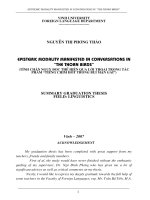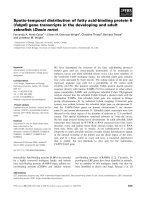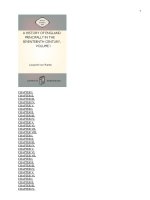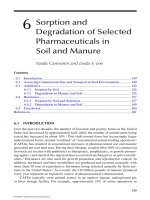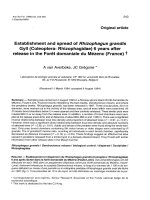6. Epistemic modality manifested in conversations in “The Thorn Birds”
Bạn đang xem bản rút gọn của tài liệu. Xem và tải ngay bản đầy đủ của tài liệu tại đây (374.99 KB, 7 trang )
<span class='text_page_counter'>(1)</span><div class='page_container' data-page=1>
<b>EPISTEMIC MODALITY MANIFESTED </b>
<b>IN CONVERSATIONS IN “THE THORN BIRDS” </b>
<b>Nguyen Thi Phuong Thao, Tran Thi Van Anh, Hoang Thi Chung </b>
<i>Vinh University </i>
Received on 18/4/2019, accepted for publication on 5/6/2019
<b>Abstract:</b> Modality has two main types, deontic and epistemic. However, our
article only deals with epistemic. English modality’s realizations are very broad,
including all word-forms: adjective, adverbs, verbs, nouns and a number of subordinate
clauses. Yet, we only consider it in the first four word-forms. The data is based on the
utterances in conversations among characters in “The Thorn Birds” written by an
Australian writer, Colleen McCullough. We find that nowhere is better for the
characters to express their feelings and attitudes toward every incident than in
conversations which are reliable source of data for modality in general and epistemic in
particular. The article also indicates the obstacles of the learners in applying “modal
verbs” properly to express their own thinking, thereby giving some causes and
solutions to ensure effective conversations.
<b>1. Introduction </b>
The term “modality” can be understood widely. It is grammaticalized by a modal
system which is formally associated along with tense, aspect and voice; particularly in
English, it is specialized in modal verbs system, such as <i>will, can, must, may</i>... In terms
of semantics, the notion, however, is related to <i>attitudes and opinions, speech acts, </i>
<i>subjective</i>, <i>non-factivity and non-assertion</i> which mean “the ideas that are concerned
with the statements that are not used to make statements of facts” (Palmer, 1986, p.4).
Modality could therefore be defined as the grammaticalization of speaker’s (subjective)
opinions and attitudes which should be reflected vividly within everyday conversations
presented by native speakers. Accordingly, <i>The Thorn Birds</i>, a bestselling novel written
by the Australian author Colleen McCullough was chosen as an authentic source for our
research which is aimed to figure out how modality of English is expressed in daily
conversations appropriately, thereby offering some implications for learning and teaching
English and some suggestions for further study.
<b>2. Theoretical background </b>
<i><b>2.1. Modality definition </b></i>
It is roughly impossible for the linguists to standardize a criteria system of
modality for every language because modality, in fact, can be performed differently
within different languages. Yet, most of them, share common sense for its definition
though they may convey it in some different terms. According to Palper F.R. (1986: 16)
“[modality]... is associated with S’s [speaker’s] attitude or opinion about what is said”. In
similar fashion, Downing and Lock (1992: 382) define <i>modality</i> as:
</div>
<span class='text_page_counter'>(2)</span><div class='page_container' data-page=2>
“… semantic categories by which speakers express their attitude toward the event
contained in the proposition as possibility, probability, necessity, volition, obligation,
permission, doubt, wish, regret, design, andtemporal notions such as usuality<i>.”</i>
In an effort to explicit some terms mentioned in the above definition, Steel et al.
(1981:21) make another proposal: “Element expressing modality will mark any of the
following: possible or the related notion of permission, probability or the related notion
of obligation, certainty or the related notion of the requirement”, as illustrated in the
following:
<i>“He may come tomorrow” </i>(Perhaps he will/ He is permitted)
<i>“The book should be on the shelf”</i> (It probably is/ It’s proper place)
<i>“He must be in the office”</i> (I am certain that he is/ he is obliged to be)
Meanwhile, Palmer (1986:14) makes a distinction between <i>modality</i> and
proposition that is related to the terms “locutionary and illocutionary” proposed by
Austin. According to him, “proposition is about what we say (locutionary) and then
<i>modality </i>is what we want to do with what we say (illocutionary) - thanking, making a
promise, making a complaint or an accusation ...”.
Above all, those linguists share a common thing which then was generalized
briefly by Nguyễn Hoà (2004: 176): “Modality is described as the expression of the
speaker’s attitude or opinion toward the content of proposition”.
Furthermore, Caffi (1994: 334, reproducing Bally, 1965: 36) defines separately
two terms “modus” and “dictum”. Modus refers to the modality marker in relation to
such dimensions as the speaker’s emotion, volition, attitude, and judgement towards what
she/he says. Dictum is the core of information in the utterance, related to the
communicative and descriptive functions of language. Thus, researching modality is to
consider two parts: the dictum means what is said and the modus deals with how is said
that is the speaker’s cognitive, emotive... attitude about what is said. For example, the
dictum <i>“he is ill”</i> could be paired with various types of modus, such as:
<i>I think that he is ill. </i>
<i>I hope that he is ill. </i>
<i>He must be ill. </i>
<i><b> 2.2. Modality classification </b></i>
Many linguists are interested in classifying modality. Noticeably, Jespersen
(1924:320) devides modality into two sub-categories:
- One of them contains an element of will: Hortative, Precative, Advisory,
Obligative, Permissive, Optative (realizable), Promissive, Intentional, Jussive.
- The other named “no element of will”:
Necessitative Assertive, Presumptive, Dubitative, Potential, Hypothetical,
Concessional, Apodictive, Conditional.
However, his proposals are judged to have so much limitation, esp. containing
little of theoretical significance, except for his recognition of two types and its terms are
used to realize “deontic” and “epistemic” then.
</div>
<span class='text_page_counter'>(3)</span><div class='page_container' data-page=3>
“evaluative” (it is a good/perfectly wonderful...) and “causal”. Unfortunately, this
consideration is not highly appreciated because they relate with actual states of affairs
that can be true or false. Despite of those limitations of some previous researchers in
classifying modality, some interesting things in their study are still rather valuable for the
later ones.
Finally, most of linguists come to agreement that modality consists of two main
kinds: <i>deontic and epistemic</i>. According to Downing and Lock (1995), speaker uses
<i>epistemic</i> to comment on the content of the clause, and non-epistemic or <i>deontic</i> to refer
to obligation and permission and thanks to them, speaker is able to carry out two
important communication functions: to comment on and evaluate an interpretation of
reality; to intervene in and bring about changes in events. Lyons et al. (1977) also agrees
with this division, but he defines them under another terms.
<i>Epistemic</i> modality which is concerned with “matters of <i>knowledge, belief”</i>
(1977: 793), or “<i>opinion </i>rather than fact” (1977: 681), and “<i>Deontic </i>modality which is
concerned with the <i>necessity</i> or <i>possibility</i> of acts performed by morally responsible
agents.” (1977: 832)
Lyons’s remark seems to be more satisfactory because it can generalize all of the
main characters of two types. When speaker uses <i>epistemic</i>, he is expressing his opinion
or attitude toward the event that he believes or knows. That is to say, speaker commits to
the truth of the utterance. Whereas speaker uses deontic to convey the action done by the
hearer or by himself. In addition, being ambitious to show the real meaning behind those
two terms, Palmer (1998) affirms that in semantic view, two basic kinds of modality
belong to two worlds: the world “perception” or “epistemic” and the world “deontic” or
“real” or “root”. Linguists have characterized as <i>root</i>, with those meanings which denote
real world <i>obligation, permission, or ability</i> (as illustrated in a) and as <i>epistemic,</i> those
which denote <i>necessity, probability, or possibility</i> in reasoning (as illustrated in b)”
a<i>. John must be home by ten. Mother won’t let him stay out any later</i>.
(Obligation)
b. <i>John must be home already. I see him coat</i>. (Possibility) (Sweetser, 1990: 49)
<b>3. Methodology </b>
Two basic methods, synthetic and analytical, are applied for this research. All of
the related utterances are collected from the novel “The Thorn Birds”, which are then
analysed based on epistemic modality. Nevertheless, the investigation is narrowed down
in the four word-forms: verbs, adjectives, adverbs, and nouns. Of all kinds of English
verbs, ten modal verbs are considered. After making some comparison among the
frequency of these four types in epistemic modality available in the novel, the data
collected from a test for students’ weakness recognition in using “modal verbs” is
synthetized for the next analysis.
</div>
<span class='text_page_counter'>(4)</span><div class='page_container' data-page=4>
three others. However, these results are not reasonable enough to conclude which kind
has the higher frequency of occurrence in the novel, because the article only looks into a
small realization of modality.
<b>4. Findings </b>
The below is the summary table to show how the four types of word forms
manifested in epistemic modality.
<b>Tab. 1: </b><i>The frequency of occurrence of epistemic modality seen from four types </i>
<i> of word-forms manifested in the conversations in “The Thorn Birds” </i>
Word-forms
Epistemic
Judgment Evidential Epistemic Deontic
Modal-verbs 52.90% 47.10% 49.40% 50.60%
Adverbs 91.20% 8.80% 90.90% 9.10%
Adjectives 78% 22% 75.00% 35.00%
Nouns 100% 100%
The indicators show that only in modal verbs, they are hardly equal; yet, in the
last three, <i>deontic</i> always accounts for rather small percentage. It is understandable
because traditionally, three of them are used to support for epistemic modality. However,
occasionally owing to these sharing, they cause us difficulty in distinguishing one from
another, as presented in the following utterance in the novel:
“<i>I certainly wouldn’t weep any tears</i>.” (p. 324) can be interpreted as judgment to
the truth of the utterance via the word “certainly” or a promise with the modal verb of
“tentative” - “would”.
Secondly, it is targeted to see how they share the percentage of occurrence in two
kinds of epistemic in spite of the fact that “there is no very clear distinction because
speaker’s judgments are naturally often related to the evidence they have” (Palmer, 1998,
p. 70). To some extent, that is true because in many cases, the next sentence is effected
by the interpretation from the previous event or by the observation of the speaker;
therefore that must be evidential, but considering that sentence itself is a judgment, such
as in the following sentence: <i>“I’m sure she’d be delighted, Archbishop”</i> (p. 370) the
speaker uses “would” not only to emphasize for her certainty that <i>she will surely </i>
<i>delighted</i> as a encouragement toward the hearer (i.e. Anne wants Ralph to come visiting
Meggie in the resort) but also she can deduce from her knowledge about Meggie’s
physical at that time. However, the result tells that the judgment takes a large percentage
via those four realizations than the evidential.
</div>
<span class='text_page_counter'>(5)</span><div class='page_container' data-page=5>
<b>5. Discussion and pedagogical implication </b>
After analysing all of the answers collected from those students, a result is not out
of expectation. Firstly, in case of multiple answers (for instance, the answer for question
4 in exercise 3 can be <i>will/might</i>), 48% answers are correct, which are still higher than
28% compared with those in the novel. Then, actually, it seems that there is much
difference between the ordinary way people use modal verbs and the characters in the
classical novel. The reasons may lay in the writing style of the writer or in some specific
cases, it depends on the situations in which the conversations occur. For instance: the
utterance of Frank: <i>“Could</i> <i>not you leave her alone, could not you keep your hands off </i>
<i>her?”.</i> As usual, <i>“can”</i> can replace <i>“could”</i> in this case, but looking at the development
of the story, this sentence is neither really a way for asking permission nor an insistence
but a request of Frank toward his father-in-law who he hates. And “could” inferring a
“strong tentative” must be an appropriate choice.
From the result, it can be recognized that, a number of Vietnamese students get
confused between “must” and “ought to”. For example, some of them answer “ought to”,
instead of “must” for question 2 in exercise 3. Because comparing with “ought to”,
“must” refers to an action more definitely, and cling to a judgement for what has
happened “I don’t know why children <i>must</i> pay for yours sins.” And they also have
difficulty in distinguishing “can”, “could” and “may” for asking permission or in some
certain cases.
The causes of the above difficulties may root from learners who are lack of a
great deal of knowledge about “modal verbs”. Obviously, they have been equipped with
only some basic background to fulfill some certain exercises, but that is not enough for a
thorough progress, esp. communication skill. Not only in the skill of using modal verbs
but in another fields, foreign language learners, certainly, have to suffer from the
negative effect of the native language. That is true if they have not been equipped enough
to make a contrast on their own. Objectively, the high percentage of wrong answers may
slightly affected the skill in taking a certain task. In this case, the students may not pay
much attention to the whole discourse or the situation they are in.
<b>6. Suggestions for the learners </b>
The first requirement is to understand thoroughly and systemically the way of
using these modal verbs. Then in order to use them fluently, there is no way but practice
frequently with classmates, or it is also extremely helpful if learners read stories in which
conversations appear in high rate. The learners can make a contrast between Vietnamese
and English modals verbs so that they will be able to avoid some confusion.
Actually, each modal verb carries each meaning under various circumstances. It
is necessary to present the context for each case, accordingly. For example, teacher can
set a situation.
<i> T: One day, your friend wants to invite you to visit his house for a dinner, so how </i>
<i>can he say? </i>
<i> S: Would you like to visit my house for dinner? </i>
</div>
<span class='text_page_counter'>(6)</span><div class='page_container' data-page=6>
<i>S: Can you give me the bowl of meat? </i>
The second answer of the student is not really appropriate with the situation.
Therefore, teacher has to infer the cultural knowledge to explain. In English “can” is also
used to make a request, but usually in informal situation. But here it is the first time you
meet his parents - a formal context, as a result, you should use “could” instead. Besides
that teacher can employ extended activities by guiding them through the use of other
modal markers with similar function.
“<i>I may not grow any bigger” </i>(modal verb)
(“The Thorn Birds”, p. 127)
“<i>It is possible I can not grow bigger” </i>(modal adjective)
<i>“I can possibly not grow bigger” </i>(modal adverb)
During this process, teacher should manage to avoid translation work since it
somehow can lead to intralingua errors and otherwise it increases the mother tongue
interference toward the target language.
<b>7. Conclusion </b>
Modality may differ from language to language, esp. in the realization system of
each. But in general, semantically it is used to express the commitment of the speaker
toward what he is saying. It involves two other sub-types called deontic and epistemic.
Yet, this article, based on the data from a great novel, examines one of them, with the
theme Epistemic modality manifested in conversations in “The Thorn Birds”. There are
quite a large number of modality’s realizations. But within the limit of an academic
article, we have only focused on four word forms: verbs (ten modal verbs), adverbs,
adjectives, nouns.
As Palmer (1998) remarks, “modality, as will be seen, does not relate
semantically to the verbs alone or primarily but the whole sentence”. Applying this
statement, we have studied not only the word-forms each self but also explore how it is
conveyed different attitude or feeling of the speaker in different contexts. And one of the
significances of our exploration via this research was find out that the frequency of
occurrence of epistemic particularly and modality generally in conversations in the novel
depends on the characters’ relationship, how they have known each other or even their
personality. The rate between the lovers and members in the same family is often higher
than the others. It can partly be explained by the fact that the frequency of conversations
among these people is more often than the rests. But it also shows the fact that the people
having close relationship usually express their cooperation in communication. Among
four realizations related to our study, ten modal verbs employ the highest percentage
(75.47%), the next is adverbs focus on “personal modality” with 18.86% and the two last
ones with the lowest rate 5.67%. In addition, the ellipsis one of the factors causing the
difficulty for the consideration also occurs at remarkable rate in every four indications
(eg: “<i>May be, he will...”</i> can be interpreted epistemic or deontic meanings if we do not
refer back the previous sentence “<i>I knew he would not come back”)</i>. This problem proves
for the fact that considering modality is sometimes necessary to see the surrounded
sentences of the whole discourse.
</div>
<span class='text_page_counter'>(7)</span><div class='page_container' data-page=7>
<b>REFERENCES </b>
Bybee, Joan L. (1985). <i>A study of the Relation between Meaning and Form</i>. John
Benjamins Publishing Company.
Caffi, C., Janney, R. W. (1994). <i>Towards a Pragmatics of Emotive Communication.</i> Journal
of Pragmatics. 22: 325-373.
Downing, Angela, and Philip Locke. <i>A University Course in English Grammar</i>. London:
Prentice Hall.
Nguyễn Hòa (2004). <i>Understanding English Semantics</i>. Hanoi: VNU.
Jespersen, O. (1924). <i>The Philosophy of Grammar</i>. Hanry Holt and Company.
Đỗ Thị Kim Liên (1998). <i>Ngữ pháp Tiếng Việt</i>. NXB Giáo dục.
Đỗ Thị Kim Liên (1999). <i>Ngữ nghĩa lời hội thoại</i>. NXB Giáo dục.
Lyons, J. (1977<i>). Semantics.</i> Cambridge: Cambridge University Press.
Đặng Thị Mạnh (2005). <i>Politeness strategies in conversation in “The Quiet American</i>”.
Graduation Thesis, VU-CFL, Vinh.
McCullough, C. (1979). <i>The Thorn Birds</i>. U.S.A: Harpers & Row.
McCullough, C. (1980). <i>Tiếng chim hót trong bụi mận gai.</i> Phạm Mạnh Hùng dịch. Hà
Nội: NXB Văn học.
Palmer, F.R. (Ed.) (1986). <i>Mood and Modality. </i>CUP: Cambridge.
Nguyễn Quang (1999). <i>A cross-cultural study of apologizing responding to apologies in </i>
<i>Vietnamese and English</i>. M.A. Thesis, VNU-CFL. Hanoi.
Rescher, N. (1968). <i>Topics in Philosophical Logic.</i> Dortrecht: Reidel.
Steel (1981) <i>A study on evidential modal markers in English.</i>
Sweetser, E.E. (1982).<i> Root and epistemic modals: causality in two worlds. </i>Proceedings
of the Annual Meeting of the Berkeley Linguistics Society 8: 484-507.
Watts, R. (2003). <i>Politeness</i>, CUP: Cambridge.
Yule, G. (1996). <i>Pragmatics</i>. OUP: Oxford.
<b>TĨM TẮT </b>
<b>TÌNH THÁI NHẬN THỨC ĐƯỢC THỂ HIỆN TRONG LỜI THOẠI </b>
<b>CỦA TÁC PHẨM “TIẾNG CHIM HÓT TRONG BỤI MẬN GAI” </b>
</div>
<!--links-->
